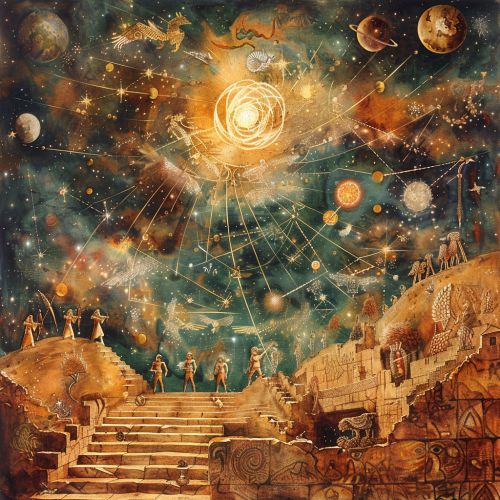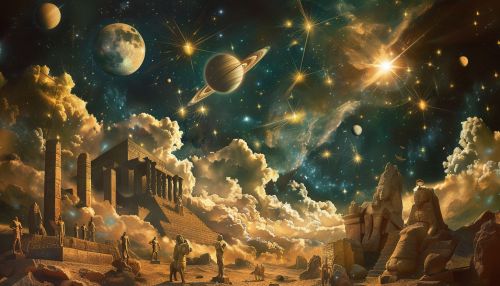Cosmological myth
Origins and Definition
A cosmological myth, also known as a cosmogonic myth, is a narrative that explains the origin of the universe and its components. These myths are a significant part of many cultures' religious and philosophical traditions, providing a framework for understanding the world and the place of humans within it.


Types of Cosmological Myths
Cosmological myths can be classified into several types, each with its own unique characteristics and themes. These include ex nihilo (creation out of nothing), chaos, world parent, emergence, earth-diver, and dualistic cosmogonies.
Ex Nihilo
Ex nihilo cosmogonies describe the universe being created from nothing. This type of cosmogony is prevalent in many monotheistic religions, including Christianity, Judaism, and Islam. In these traditions, a single, all-powerful deity is often responsible for the creation of the universe.
Chaos
Chaos cosmogonies depict the universe emerging from a state of disorder or chaos. This type of cosmogony is common in ancient Greek and Norse traditions. In these myths, the universe is often formed from the conflict between forces of order and chaos.
World Parent
World parent cosmogonies involve the universe being born from the union or separation of primordial parents. This type of cosmogony is found in many polytheistic cultures, including the ancient Egyptian and Maori traditions.
Emergence
Emergence cosmogonies describe the universe as emerging from another, often inferior or less complex, reality. This type of cosmogony is common in many Native American and Aboriginal Australian traditions.
Earth-Diver
Earth-diver cosmogonies involve a divine being or animal diving into the primordial ocean to bring up the earth. This type of cosmogony is found in many Native American and Siberian traditions.
Dualistic Cosmogonies
Dualistic cosmogonies depict the universe as the result of the interaction between two opposing principles, such as light and darkness, good and evil, or male and female. This type of cosmogony is common in Zoroastrianism and certain Gnostic traditions.
Role and Significance of Cosmological Myths
Cosmological myths play a crucial role in shaping a culture's worldview and understanding of the universe. They provide answers to fundamental questions about the origins of the universe, the nature of existence, and the purpose of life. These myths also serve to legitimize social norms and values, establish cultural identity, and provide a sense of continuity and purpose.
Interpretations and Analyses
Interpretations of cosmological myths vary widely, with different scholars and traditions offering diverse perspectives. Some view these myths as literal accounts of historical events, while others interpret them as symbolic or metaphorical narratives. Many modern scholars analyze cosmological myths through the lens of comparative mythology, psychology, sociology, and anthropology, seeking to understand their cultural, psychological, and social functions.
